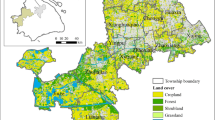Abstract
Policy and decision makers dealing with environmental conservation and land use planning often require identifying potential sites for contributing to minimize sediment flow reaching riverbeds. This is the case of reforestation initiatives, which can have sediment flow minimization among their objectives. This paper proposes an Integer Programming (IP) formulation and a Heuristic solution method for selecting a predefined number of locations to be reforested in order to minimize sediment load at a given outlet in a watershed. Although the core structure of both methods can be applied for different sorts of flow, the formulations are targeted to minimization of sediment delivery. The proposed approaches make use of a Single Flow Direction (SFD) raster map covering the watershed in order to construct a tree structure so that the outlet cell corresponds to the root node in the tree. The results obtained with both approaches are in agreement with expert assessments of erosion levels, slopes and distances to the riverbeds, which in turn allows concluding that this approach is suitable for minimizing sediment flow. Since the results obtained with the IP formulation are the same as the ones obtained with the Heuristic approach, an optimality proof is included in the present work. Taking into consideration that the heuristic requires much less computation time, this solution method is more suitable to be applied in large sized problems.
Similar content being viewed by others
References
Ahuja RK, Magnanti TL, Orlin JB (1993) Network flows: theory algorithms, and applications. Prentice Hall, New York
Avolio MV, Crisci GM, D’Ambrosio D, Di Gregorio S, Iovine G, Rongo R, Spataro W (2003) An extended notion of cellular automata for surface flows modelling. WSEAS Trans Comput 2:1080–1085
Avolio MV, Di-Gregorio S (2004) A cellular “blocks” model for large surface flows and applications to lava flows. Lect Notes Comput Sci 3305:415–424
Benenson I (1998) Multi-agent simulation of residential dynamics in the city. Comput Environ Urban Syst 22:25–42
Bogaart PW, Torfs P, Troch A (2006) A multiple flow direction algorithm for computing intra hillslope length maps. Geogr Res Abstr 8:09811
Church R, Gerrard R, Gilpin M, Stine P (2003) Constructing cell-based habitat patches useful in conservation planning. Ann Assoc Am Geogr 93:814–827
Coulthard TJ, Kirkby MJ, Macklin MG (1999) Modelling the impacts of Holocene environmental change in an upland river catchment, using a cellular automata approach. In: Fluvial process and environmental change. Wiley, New York, pp 31–46
Coulthard TJ, Kirkby MJ, Macklin MG (2000) Modelling geomorphic response to environmental change in an upland catchment. Hydrol Process 14:2031–2045
Coulthard TJ, Macklin MG, Kirkby MJ (2002) A cellular model of holocene upland river basin and alluvial fan evolution. Earth Surf Processes Landf 27:269–288
Di-Gregorio S, Serra R (1999) An empirical method for modelling and simulation some complex macroscopic phenomena by cellular automata. Future Gener Comput Syst 657:1–13
D’Ambrosio D, Di-Gregorio S, Gabriele S, Gaudio R (2001) A cellular automata for soil erosion by water. Phys Chem Earth 26:33–39
Failfield J, Leymarie P (1991) Drainage networks from grid digital elevation models. Water Resour Res 27:709–717
Gilbert KC, Holmes DD, Rosenthal RE (1985) A multiobjective discrete optimization model for land allocation. Manag Sci 31:1509–1522
Jiménez A, Posadas AM (2006) A Moore’s cellular automaton model to get probabilistic seismic hazard maps for different magnitude releases: a case study for Greece. Tectonophysics 423:35–42
Karafyllidis WW, Gardner RH, Turner MG, Romme WH, Despain DG (2000) A model for predinting forest fire spreading using cellullar automata. Ecol Model 99:163–169
Longley PA, Goodchild MF, Maguirre DJ (2005) Geographic information systems and science, 2nd edn. Wiley, New York
Murray AB, Paola C (1994) A cellular model of braided rivers. Nature 371:54–57
Parsons JA, Fonstad MA (2007) A cellular automata model of surface water flow. Hydrol Process 21:2189–2195
Qin C, Xhu AX, Pei T, Li B, Zhou C, Yang L (2007) An adaptative approach to selecting a flow-partition exponent for a multiple-flow-direction algorithm. Int J Geogr Inf Sci 21:443–458
Stevens D, Dragicevic S, Rothley K (2006) Icity: a gis-ca modelling tool for urban planning and decision making. Environ Model Softw 22:1–13
Thomas R, Nicholas AP (2002) Simulation of braided river flow using a new cellular routing scheme. Geomorphology 43:179–195
Tobler W (1979) Cellular geography. In: Philosophy in geography. Reidel, Dordrecht, pp 379–386
Van-Orshoven J (2007) Introduction to spatial data modelling and functionality of geospatial technology. Department of Earth and Environmental Sciences. K.U. Leuven
Vanegas P, Cattrysse D, Van Orshoven J (2008) Comparing exact and heuristic methods for site location based on multiple attributes: an afforestation application. Lect Notes Comput Sci 5072:389–404
Vanegas P, Cattrysse D, Van Orshoven J (2009) Spatial interaction model for locating cells minimizing flow. Technical report, Katholieke Universiteit Leuven, Centre for Industrial Management
White R, Engelen G (2000) High-resolution integrated modelling of the spatial dynamics of urban and regional systems. Comput Environ Urban Syst 24:383–400
Winston WL (1994) Operations research, applications and algorithms. International Thomson Publishing, Stamford
Wolock DM, McCabe GJ Jr (1995) Comparison of single and multiple flow direction algorithms for computing topographic parameters in topmodel. Water Resour Res 31:1315–1324
Wu F (1998) An experiment on the generic polycentricity of urban growth in a cellular automatic city. Environ Plan 24:323–343
Author information
Authors and Affiliations
Corresponding author
Rights and permissions
About this article
Cite this article
Vanegas, P., Cattrysse, D. & Van Orshoven, J. Allocating reforestation areas for sediment flow minimization: an integer programming formulation and a heuristic solution method. Optim Eng 13, 247–269 (2012). https://doi.org/10.1007/s11081-011-9138-2
Received:
Accepted:
Published:
Issue Date:
DOI: https://doi.org/10.1007/s11081-011-9138-2




